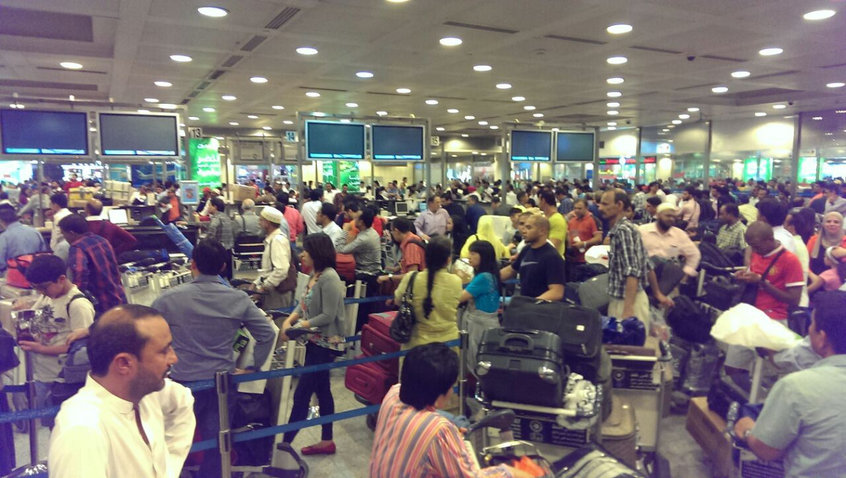The status of the project to build a new terminal at Kuwait’s international airport is uncertain after a committee in the public works department recommended that all bids be scrapped.
Kuna, the country’s official news agency, reported Abdul Aziz Al Ebrahim, the minister for public works, as saying that a technical committee in his ministry had argued that all bids be rejected. Ebrahim did not say why the committee had reached its decision, however last week newspaper Al Watan quoted a ministry source as saying that the lowest bid exceeded the budget for the project by 39%.
Cancellation of the airport tender is a good decision, which will preserve public funds. We now expect from the government to retender the contract within the budget limits– A Kuwaiti member of parliament
In November, it was reported that the lowest bid was made by a consortium led by Kuwaiti contractor Kharafi National and Limak Holdings of Turkey, which offered to build the Foster + Partners design for $4.8bn, and it was generally expected that work was about to begin. However, it seems that the scheme has once again been disrupted by concerns over its cost. This is not entirely unexpected, as the question of price has dogged the terminal since its inception and led to one of the most painfully drawn-out tendering processes in recent history.Â
Turbulence
The idea for the terminal was first proposed as far back as 2004, but the decision to go ahead and build it was taken in October 2011, when the Kuwaiti government’s Directorate General of Civil Aviation announced that a design had been chosen, and that work would begin in 2012 and end in 2016.Â
The new terminal was to be a striking building in the distinctive high-tech style of Foster + Partners. The floorplan was in the shape of a trefoil, each side of which was 1.2km long; they would meet in a dramatic 25m-high central atrium. The aim was to expand capacity to an eventual 25 million passengers a year and to position the airport as a regional hub.
On the face of it, the project was urgent. The airport had two terminals, its main building and the Sheikh Saad, completed in 2008, which was partly intended to cater for private jet owners. This gave it a capacity of about 9 million passengers a year, but by 2009 – just before the financial crisis cut demand – it was trying to process more than 11 million.Â
In May 2012, Fawaz Abdul Aziz Al-Farah, the president of Kuwait Civil Aviation, said $3bn would be spent on building a 130,000-sq-m terminal, while a further $3bn was earmarked for a runway expansion, enhanced control tower operations and the construction of a new cargo facility. The aim was to increase capacity to 13 million by the end of 2016.
However, nothing more was heard until in November of that year when Abdul Aziz Al-Kulaib, an undersecretary at the Public Works Ministry, announced that a tender for a $3.2bn terminal project would be let the following month.
At first it seemed that rapid progress was being made: in March 2013, it was reported that the government was about to choose a winner from the 18 foreign companies that had entered the contest. At that time the terminal was to have cost $3.2bn and was scheduled for completion in 2020.

Passengers queuing for departure during the Eid holiday rush (Source: Kuwait Up2 Date)
By 2013, congestion at the airport was becoming serious, with some flights having to switch at short notice between the airport’s main terminal and Sheikh Saad to avoid putting further pressure on baggage reclaim systems and car parking capacity.Â
Despite this, the renewed attempt to reach take-off velocity on the new terminal stalled and in September 2013, the government said it would re-tender the terminal project with the aim now of beginning work in April 2014.Â
The Ministry of Public Works then invited 27 firms to bid, of which 16 responded positively, but this effort also proved abortive: by June 2014, most of the bidders had dropped out. The Arabic daily Al Rai reported sources close to the scheme as saying “contracting companies found the conditions discouraging and incapacitating and this pushed the Ministry of Public Works to put the project indefinitely on hold”. Â
Money worries
Among the conditions being demanded of bidders was one that said the winning contractor was required to invest at least $1.3bn in civic projects. Another said that consortiums would not be allowed and a third listed a series of additional fees that the victorious firm would have to pay. Â
A source told Zawya: “Kuwait will be the biggest loser of the project’s postponement as this hurts its regional and global reputation and contradicts plans to turn Kuwait into a regional financial and commercial centre.”
Yet another tender was then launched, and this time European bidders complained that they were up against several Chinese contractors, including China State Construction Engineering Corporation (CSCEC), that took an “aggressive approach to cost cutting”. According to a report in the Kuwait Times in September 2014, this prompted a number of British rivals to withdraw. A source at one of these companies told the paper that a Chinese consortium was certain to win the “price war”. He said: “My company withdrew although we had provided all guarantees and securities demanded by the Ministry of Public Works.”
Those fears appeared to be misplaced when it was reported that a team led by Kharifa National, and containing Limak Holdings of Turkey, had offered to do the work for $4.8bn. It was later reported that CSCEC had offered to do the work for $5.6bn, Abu Dhabi contractor Arabtec had priced it at $5.83bn and Italy’s Astaldi had bid $5.9bn.
Characteristically, this announcement caused widespread confusion as media outlets announced that the job had been officially awarded; in fact it was just an announcement that the Kharifa team had entered the lowest bid: in fact, the tenders were to be sent to the Ministry of Public Works for further consideration.
Last month, it was reported that the ministry was thinking of starting again from the beginning. Three options were under consideration, one of which involved changing the scope of the work to exclude some of the supporting infrastructure.Â
A ministry report on the terminal said: “This option involves new terms, including dividing the project into separate packages for private sector contractors and leaving the execution of the infrastructure and other major construction works to the government, given their high costs.” It did not say what the other two options were, or explain the reasoning behind the re-tender.Â
Where now?
The latest blow to the project has probably been delivered by the fall in oil prices over the past six months. The possibility of retendering was raised after calls by members of the Kuwaiti parliament to secure lower prices, and Al-Watan reported that the ministry decided to question the tender amid fears that the country’s budget could be in deficit.Â
“Cancellation of the airport tender is a good decision, which will preserve public funds. We now expect from the government to retender the contract within the budget limits,” one member of parliament told the paper.Â
Another member said: “The procedures to prequalify bidding companies were faulty. We have been told that 24 companies bid but actually there were only four.”
There is no doubt that Kuwait needs a larger airport, and there is no doubt, therefore, that if this tender is cancelled, another will be issued. What is more doubtful is how many firms will want to enter it…






